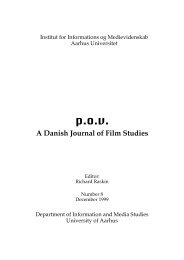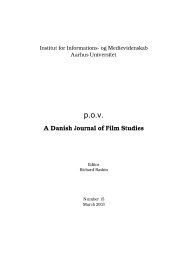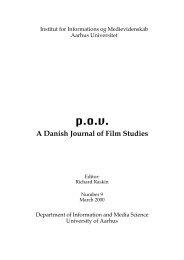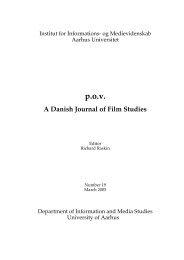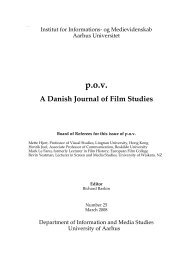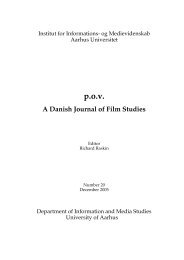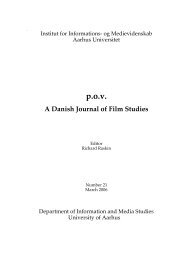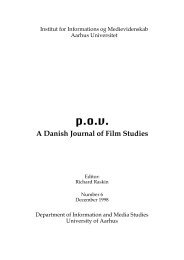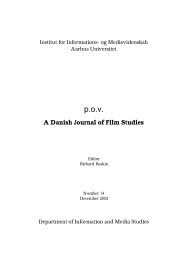The Face of Time - POV - Aarhus Universitet
The Face of Time - POV - Aarhus Universitet
The Face of Time - POV - Aarhus Universitet
You also want an ePaper? Increase the reach of your titles
YUMPU automatically turns print PDFs into web optimized ePapers that Google loves.
136 p.o.v. number 13 March 2002<br />
ine putting these pre-imagined scenes and blocks together into a<br />
whole film. In particular they were encouraged not to put too much<br />
energy into imagining how to connect scenes or blocks to one another,<br />
but rather to keep thinking about them as provisional and<br />
free-floating building blocks which could be used to build several<br />
possible films.<br />
<strong>The</strong> “documentarists” initially resisted this method. Early in the<br />
course, their “filmic imaginations” really did not get going until<br />
they had concrete material to work with. When they had done field<br />
research – begun to get to know the people, the places, the situations,<br />
the actions and so on, that they were going to film - then they<br />
could imagine ways <strong>of</strong> filming these things. So they tended to put<br />
<strong>of</strong>f pre-imagining until late in the development process. This <strong>of</strong>ten<br />
meant, in the films they did early in the course, that they were not<br />
sufficiently prepared when the filming started.<br />
Later in the course most <strong>of</strong> the “documentarists” learned to use<br />
their filmic imaginations earlier in development and tended to find<br />
the change energizing and motivating. <strong>The</strong>y understood that all the<br />
filmic solutions they had imagined and had rejected were, in a<br />
sense, still “there” and helped them to focus on what they should<br />
film, no matter how they filmed it. A number <strong>of</strong> them, year after<br />
year, reported that they felt they could “improvise” better during<br />
the filming because <strong>of</strong> the imagined scenes they had rejected. Some<br />
<strong>of</strong> them even reported that the pre-imagined, but rejected scenes<br />
helped them during the editing. I regarded these things as successes<br />
for the method.<br />
For the “fictionalists,” I believe, the method exaggerated, perhaps<br />
even created the “field research angst syndrome.” <strong>The</strong>y felt I was<br />
encouraging them to build up “finished” film scenes in their heads



